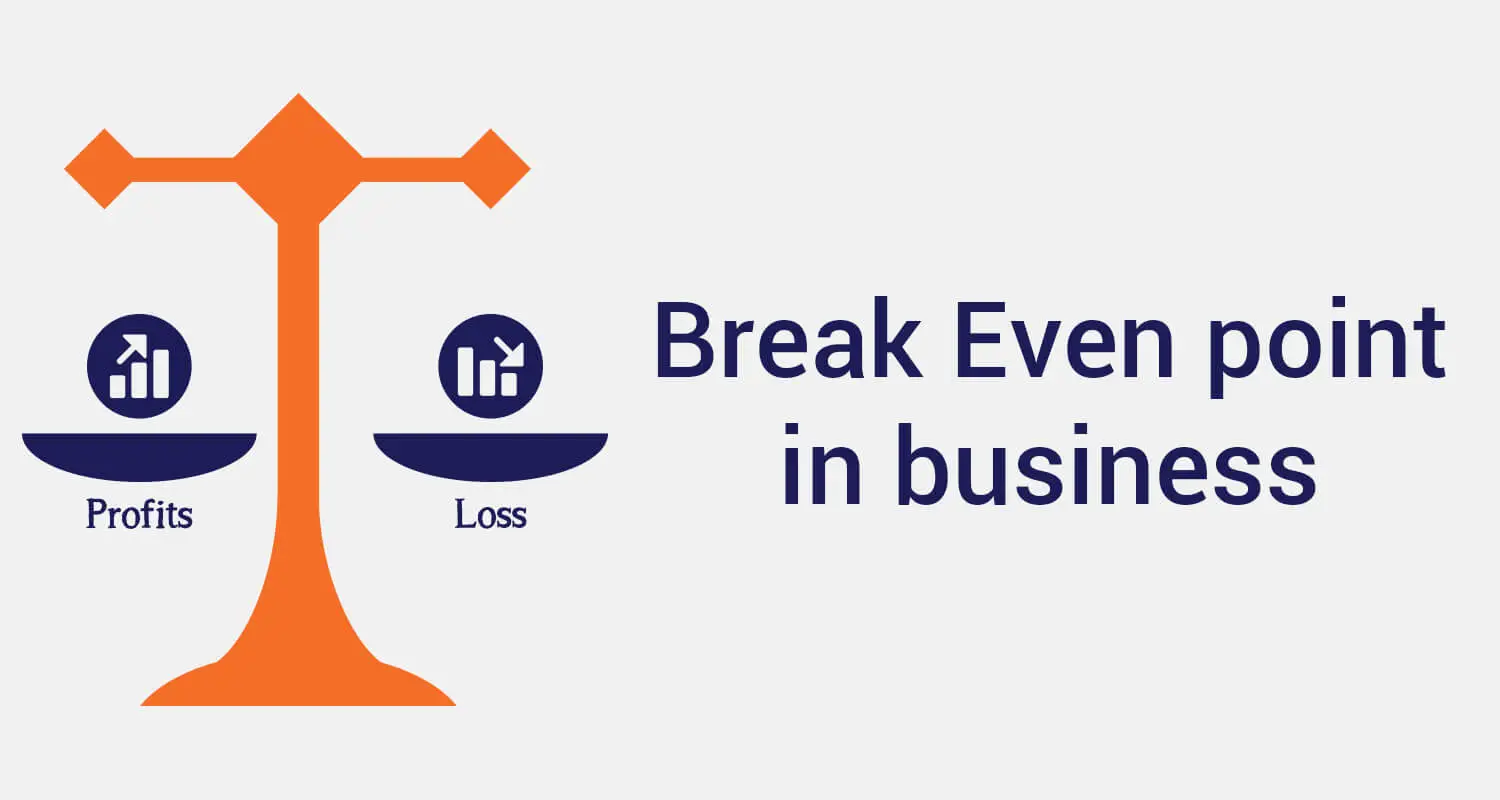Break Even Point: Meaning, Importance, Analysis & Calculation

Have you ever faced a business failure? It is quite a common problem with nearly 50% of small businesses as the first five years of a business are infamously tough. A solid grasp and knowledge of the breakeven point in business is one key factor that separates successes from failures. The break-even point in business is that concept that can pull you out of a difficult business situation by making informed financial decisions. This blog tries to give you a knowhow into the breakeven point and the importance for business owners.
What Is the Breakeven Point in Business?
When you do your business accounting, you may notice that at one point your company’s total costs and total revenue are equal. That point is the breakeven point in your business (BEP) and it is at this juncture your company’s operations become profitable from an unprofitable status. Your business needs to reach the breakeven point to see it making profits. The breakeven point in your business can also be used in other ways across finance like trading.
What is the Importance of a Breakeven Point in business?
The breakeven point of business is important as it sets the sales level you need to reach to cover all your costs and ensure no losses are incurred. For all your strategic decision-making, be it for pricing, cost control, or sales, identifying your breakeven point is mandatory.
What is a break-even analysis of a business?
A breakeven analysis is a process of calculating what quantity of product must a small business sell to be profitable. The understanding of a break-even analysis of a business helps entrepreneurs think of a pricing strategy to cover costs and generate a gross profit.
Why do you need to analyse a breakeven point of a business?
An analysis of the breakeven point of a business gives you the understanding to chalk out the financial dynamics of a business, guiding pricing, cost management, and strategic planning, and ensuring long-term financial health and stability. The factors for a financially stable business have been discussed here:
- Establishing profitability: Set sales targets and measure when the business will start generating profit
- Strategic Pricing: Make informed decisions about pricing products or services, we need to set prices high enough to cover costs while remaining competitive.
- Cost Maintenance: Identify the costs that need to be controlled or reduced to improve financial performance.
- Financial Budgeting: The budgeting and pre-empting of various scenarios like changes in costs, prices, or sales volume helps in times of uncertainty.
- Investment Choices: Investors and lenders can assess the financial viability of a business and understand the risk and potential return on investment.
- Operational Guidance: Can fathom operations expanding production, opening new locations, or increasing marketing efforts.
Sapna aapka. Business Loan Humara.
Apply NowHow to calculate a break-even point of a business?
There is a process to identify your business’s breakeven point for your products or services. You must know the costs for both operating your business and making your profit for the calculation.
The formula for a break-even analysis calculates how many products you need to sell to break even:
Break-even point in quantity of units sold = Fixed costs/(Price per unit – Variable cost per unit)
where:
- Fixed Costs are costs that do not change with varying factors like production output (e.g., salary, rent, insurance)
- Sales Price per Unit is the selling price per unit
- Variable Cost per Unit is the variable cost which depends on how much product is produced and sold. Say if you manufacture or sell a higher quantity of products, the variable costwill increase, and vice versa (e.g. Raw materials and payment processing fees)
So, the sales price per unit minus variable cost per unit results in the contribution margin per unit. For example, if a magazine’s selling price is $100 and its variable costs are $25 to make it, $75 is the contribution margin per unit and contributes to offsetting the fixed costs.
What is the Contribution Margin in a business? Is breakeven and contribution margin different?
Break-even analysis also deals with the contribution margin of a product. The excess between the selling price and total variable costs is known as the contribution margin. Say, if the price of a product is Rs.200, total variable costs are Rs. 80 per product and the fixed cost is Rs. 30 per product, then the contribution margin of the product is Rs. 120 (Rs. 200 – Rs. 80). This Rs. 120 is the revenue collected to cover the fixed costs. Fixed cost is not considered in the calculation of the contribution margin.
Some Benefits of Break-even analysis in a business
Listed below are some benefits when calculating the break-even point in a business.
- Track missing expenses: You may forget some expenses while making out the business plan. A break-even analysis can help you review all financial commitments to figure out the break-even point in your business. This analysis is essential to track the sudden surprises down the business’s journey and keep the business prepared.
- Focus on revenue targets: When you have completed yourbreak-even analysis, you will get an idea of how much you need to sell to be profitable. You can take a cue from this to set goals for your sales team.
- Finance your business: Break-even analysis is very important for any business plan as this is key in getting funds from others for your business. To fund your business, you must prove that your plan is viable.
Competitive pricing: Analysingthe break-even point will help in pricing the products better. The break-even tool is very effective in determining the best price of a product that can get maximum profit without increasing the existing price.
Are there any Limitations to the Breakeven Point of business?
While the breakeven point of business is a valuable tool for decision-making, it has several limitations.
Breakeven depends on the assumption that cost can be divided into fixed and variable sections. But some costs do not fit clearly in these sections. Semi-variable costs which also have both fixed and variable categories, can complicate the precision of the breakeven calculation by changing the point in units.
A further limitation of the breakeven point is that it assumes that sales prices, variable costs per unit, and total fixed costs remain constant, which does not align. The price of goods and the cost of raw materials sold often fluctuate. Also, the fixed costs can even change. This makes it almost impossible to always have an updated accurate breakeven point.
The break even analysis ignores qualitative factors such as market competition, customer satisfaction, and product quality. While the breakeven point focuses on financial metrics, successful business decisions require an all-inclusive view that goes beyond the breakeven number.
While break-even analysis for a single product is simple, the calculation gets more complex if your business sells more than one product or service. So breakeven points may not be ideal for businesses with multiple products.
The breakeven is less effective for long-term planning. The break-even analysis can be useful for short-term planning but the accuracy tends to decrease over time because the costs factored in your initial calculation naturally fluctuate.
A break-even analysis gives the view of your business at a single point in time, so you have a limitation in planning.
FAQs
Q1. What can improve the break-even point of a business?Ans. The break-even point will increase by any of the following: If there is an increase in the amount of the company's fixed costs/expenses, if you notice an increase in the per unit variable costs/expenses, and if there's a decrease in the company's selling prices.
Q2. What if there is no break-even point in a business?Ans. If the break-even point is null, it means that the business does not have any fixed costs. If this is the scenario, the variable costs are considered as the total costs, and the business achieves the break-even point when its total revenue equals its total variable costs.
Q3 Is break-even a profit or loss in a business?Ans. A break-even point is to make a profitable business. This is the point where your total revenue (sales or turnover) equals total costs. There is neither profit nor loss in your business at the breakeven point.
Q4. Is there a good time to break even in a business?Ans. Usually, a standard break-even time is between 6-18 months. If it takes a longer time to reach a break-even point, based on your calculation, then you may need to relook at your plans to increase the price, reduce cost, or do both.
Sapna aapka. Business Loan Humara.
Apply NowDisclaimer: The information contained in this post is for general information purposes only. IIFL Finance Limited (including its associates and affiliates) ("the Company") assumes no liability or responsibility for any errors or omissions in the contents of this post and under no circumstances shall the Company be liable for any damage, loss, injury or disappointment etc. suffered by any reader. All information in this post is provided "as is", with no guarantee of completeness, accuracy, timeliness or of the results etc. obtained from the use of this information, and without warranty of any kind, express or implied, including, but not limited to warranties of performance, merchantability and fitness for a particular purpose. Given the changing nature of laws, rules and regulations, there may be delays, omissions or inaccuracies in the information contained in this post. The information on this post is provided with the understanding that the Company is not herein engaged in rendering legal, accounting, tax, or other professional advice and services. As such, it should not be used as a substitute for consultation with professional accounting, tax, legal or other competent advisers. This post may contain views and opinions which are those of the authors and do not necessarily reflect the official policy or position of any other agency or organization. This post may also contain links to external websites that are not provided or maintained by or in any way affiliated with the Company and the Company does not guarantee the accuracy, relevance, timeliness, or completeness of any information on these external websites. Any/ all (Gold/ Personal/ Business) loan product specifications and information that maybe stated in this post are subject to change from time to time, readers are advised to reach out to the Company for current specifications of the said (Gold/ Personal/ Business) loan.



